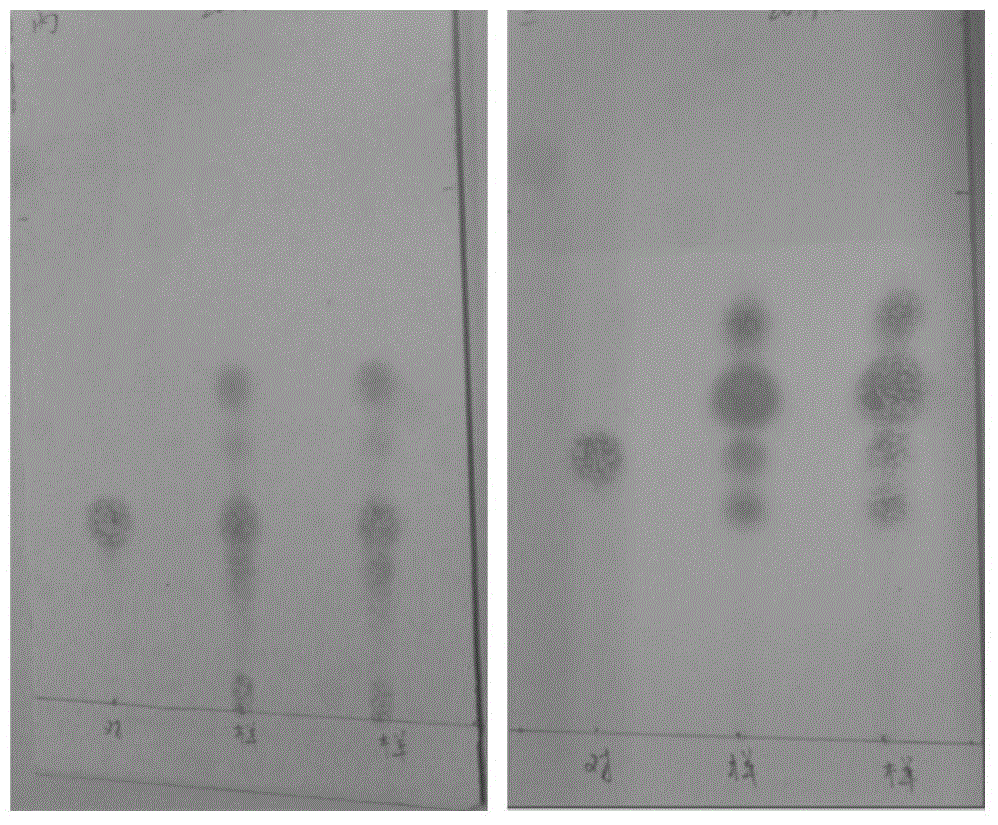A method for identifying the cell wall skeleton of Nocardia rubrum
A Nocardia rubrum, cell wall technology, applied in measuring devices, instruments, scientific instruments, etc., can solve the problem of difficult to distinguish components, and achieve the effect of easy separation, good separation effect and strong reliability
- Summary
- Abstract
- Description
- Claims
- Application Information
AI Technical Summary
Problems solved by technology
Method used
Image
Examples
Embodiment 1
[0039] (1) Spotting
[0040] Use a 2B pencil to draw a straight line at 1.0 cm from the bottom edge of the thin-layer plate as the sampling baseline, and draw 3 dots on the sampling baseline at a distance of 1.0 cm, and respectively apply the reference solution and the test solution. Take 2 μl each of the alanine reference solution and the test solution, and spot them on the thin-layer plate. Take 5 μl each of the mesodiaminopimelic acid reference solution and the test solution, and spot them on a thin-layer plate.
[0041] (2) expand
[0042] Put the thin-layer plate of the alanine reference substance solution and the test solution into the n-butanol-glacial acetic acid-water (8:3:1) developer, and place the meso-diaminopimelic acid Put the TLC plates of the reference substance solution and the test solution into the developing agent of sodium lauryl sulfate-n-butanol-n-hexane-water (6:25:6:20). The depth of immersion in the developer is 0.5cm from the bottom of the thin-l...
Embodiment 2
[0048] (1) Spotting
[0049] Use a 2B pencil to draw a straight line at 1.0 cm from the bottom edge of the thin-layer plate as the sampling baseline, and draw 3 dots on the sampling baseline at a distance of 2.0 cm, and respectively apply the reference solution and the test solution. Take 2 μl each of the alanine reference solution and the test solution, and spot them on the thin-layer plate. Take 5 μl each of the mesodiaminopimelic acid reference solution and the test solution, and spot them on a thin-layer plate.
[0050] (2) expand
[0051] Put the thin-layer plate of the alanine reference substance solution and the test solution into the n-butanol-glacial acetic acid-water (8:3:1) developer, and place the meso-diaminopimelic acid Put the TLC plates of the reference substance solution and the test solution into the developing agent of sodium lauryl sulfate-n-butanol-n-hexane-water (6:25:6:20). The depth of immersion in the developer is 1.0cm from the bottom of the thin-l...
Embodiment 3
[0057] (1) Spotting
[0058] Use a 2B pencil to draw a straight line at 1.0 cm from the bottom edge of the thin-layer plate as the sampling baseline, and draw 3 dots on the sampling baseline at a distance of 1.5 cm, and respectively apply the reference solution and the test solution. Take 2 μl each of the alanine reference solution and the test solution, and spot them on the thin-layer plate. Take 5 μl each of the mesodiaminopimelic acid reference solution and the test solution, and spot them on a thin-layer plate.
[0059] (2) expand
[0060] Put the thin-layer plate of the alanine reference substance solution and the test solution into the n-butanol-glacial acetic acid-water (8:3:1) developer, and place the meso-diaminopimelic acid Put the TLC plates of the reference substance solution and the test solution into the developing agent of sodium lauryl sulfate-n-butanol-n-hexane-water (6:25:6:20). The depth of immersion in the developer is about 1.0cm from the bottom of the ...
PUM
 Login to View More
Login to View More Abstract
Description
Claims
Application Information
 Login to View More
Login to View More - R&D
- Intellectual Property
- Life Sciences
- Materials
- Tech Scout
- Unparalleled Data Quality
- Higher Quality Content
- 60% Fewer Hallucinations
Browse by: Latest US Patents, China's latest patents, Technical Efficacy Thesaurus, Application Domain, Technology Topic, Popular Technical Reports.
© 2025 PatSnap. All rights reserved.Legal|Privacy policy|Modern Slavery Act Transparency Statement|Sitemap|About US| Contact US: help@patsnap.com



